

If your moped doesn't want to start or has difficulties with it, you better check the spark plug, it's probably filthy or worn out. If the plug is contaminated, try to clean it, but be careful not to damage the isolation of the plug. If the plug feels greasy then oil leeks into the cylinder, see oil-leaks.
If you've cleaned the spark plug - or better, you've bought a new one (type C-7 HS)- then put the voltage connector on the plug and hold the bottom of the plug to the metal of the engine. Now rotate the pedals and check if the plug emits sparks. If the sparks are emitted sideways, the plug is damaged or the gap between the high voltage pin and the ground pin is too large. This space should be about 0.6mm (0.02362").
If it sparks well, screw the spark in the cylinderhead manually until the plug is at the end, then tighten it carefully with a special wrench, but don't tighten it too hard or you'll break the screw thread.
If there are few sparks, then there is a great chance that the contact breaker points (ordernr. 30202-063-004) aren't working well, these points are behind the flywheel.
The first thing that you should try is to adjust the contact breaker points.
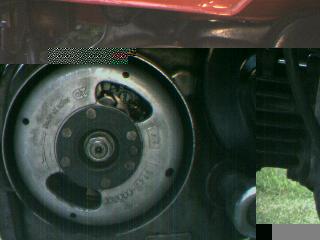
the contact breaker points are behind the flywheel
the adjustment screw is good visible
You don't have to dismount the flywheel, just turn the flywheel until one of the two gaps is in front of the contact breaker points. Then you'll see a screw on these points. If you loosen this screw you can rotate the points.
Their are two marks on the flywheel: F and T. There is also a mark on the housing of the flywheel (at the top left). Now if you turn the flywheel in the direction of the arrow (located on the flywheel) then the points should open at the same moment that the F mark crosses the mark on the housing.
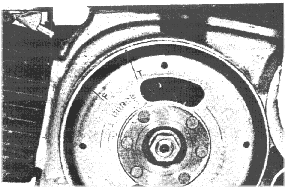
Marks on the flywheel,
T is now in line with the mark on the housing
The easiest way of doing this is by using a cigarette paper: put the paper between the contact breaker points when 'T' is at the housing mark. Turn back the flywheel past 'F' en then turn it forwards again. The paper should come out at mark 'F'.
If adjusting the breaker contacts doesn't solve the problem then you should consider replacing them. In this case you must dismount the flywheel. If you don't have the right tools for this job, it can be tricky.
The flywheel can be dismounted by loosening the nut at the centre of the wheel. First the flywheel must be blocked. The best tool for this is a kind of spanner with two pins on it, these pins must fit in the two holes at the edge of the flywheel. If you don't have this tool, you will have to block the wheel in a different way: I always use a big set of pliers. Just be careful that you don't damage the ignition coils behind the flywheel.
If the wheel is blocked, loosen the screw at the centre. To take the flywheel of the shaft, you need a pulley puller, there are two kinds of pulley pullers, see the two pictures below:

Pulley puller with screw thread
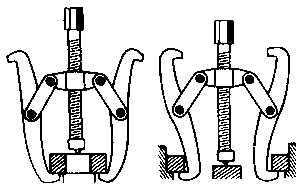
Pulley puller with hooks
If you use the puller with the hooks, be careful with it, you can easily damage the ignition coils behind the flywheel. You better use the one with screw thread; this one is also much easier. You will also notice that the size of the screw thread is bigger than the screw thread used on pullers designed for bikes.
Now take out the old points and put in the new ones, adjust them as described above.
If you use new points, grease the ridge with ball bearing grease.
Another part that causes a lot of problems is the carburettor as there are a lot of little tubes in it which are easily contaminated.
First check the air cleaner. If it's blocked, try cleaning it with an airgun from the inside to the outside or buy a new one. You can also try to wash it in benzene. Let the air cleaner dry well afterwards.
If the air cleaner is still in good shape, the carburettor needs cleaning.
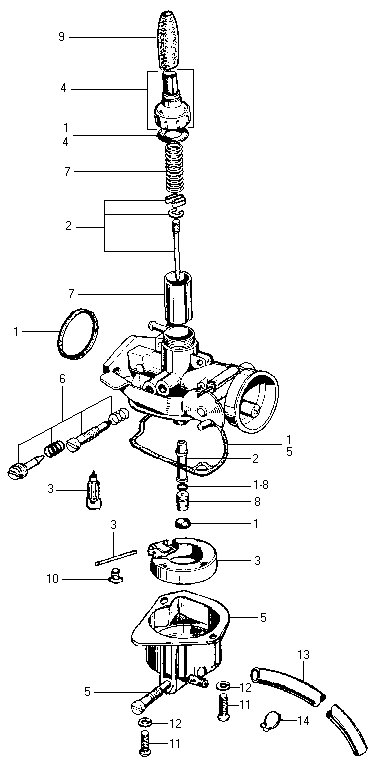 |
| |||||||||||||||||||||||||||||||||||
If you have an old type carburettor (the cable tensioner at the top has a twist), you can download a composite drawing and a parts list: carb.zip (38Kb).
The main jet set (nr. 8) is very sensitive for dust and dirt, buy carburettor cleaner spray, dismount parts 2, 5, 6 and 8 and clean these parts with the carburettor cleaner. Also clean all the other tubes in the carburettor. Before you start dismounting the parts screw the air screw nr.6 until the end and count the turns. If you mount the screw afterwards, you can put it back on the right position. Clean the holes with an airgun. Never use sharp tools to clean the tubes!
Don't overtighten the two M6 screws if you remount the carburettor onto the inlet manifold, otherwise the flange will warp. If the flange is bended, the carburettor will draw air from the flange and the engine wiil not be able to run stable anymore.
Adjusting the carburettor:
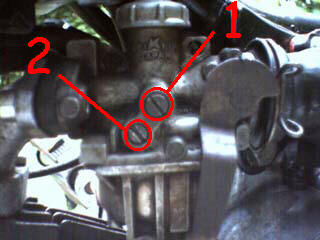
First you turn out the gasscrew (top adjustingscrew, nr.1) just until the engine wants to stops running.
Then you start turning the airscrew (bottom adjusting screw, nr. 2) until you find the point that the engine runs the fastest. After this you screw the gasscrew back in the carburettor until the engine makes 1500tr/min. This is the speed at which the rearwheel starts to move (make sure it is off the ground).
I have noticed that it is better to screw the gasscrew a bit further into the carburettor, othwerwise the engine stops easily.
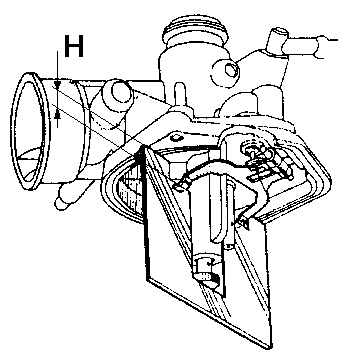
In order to adjust the float set, you 'll have to make a kind of feeler gauge.
The correct distance 'H' is 5 mm + 0.1 mm. The float spring may not pressed.
If the engine still won't run, check the cylinder or the gearbox. Also check the electrical wiring as there might be a broken wire.
ã
Kris Maeswith the co-operation of Hans Hartman